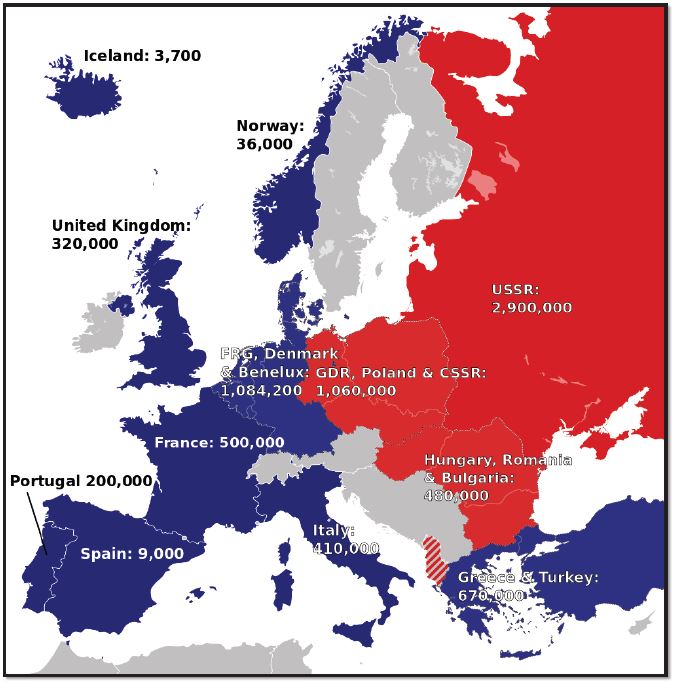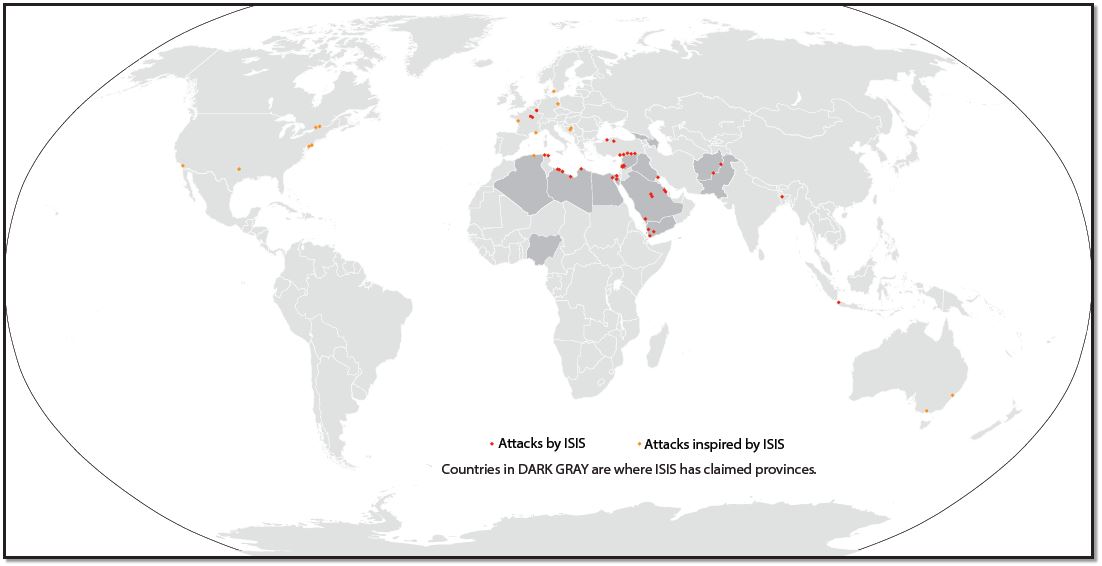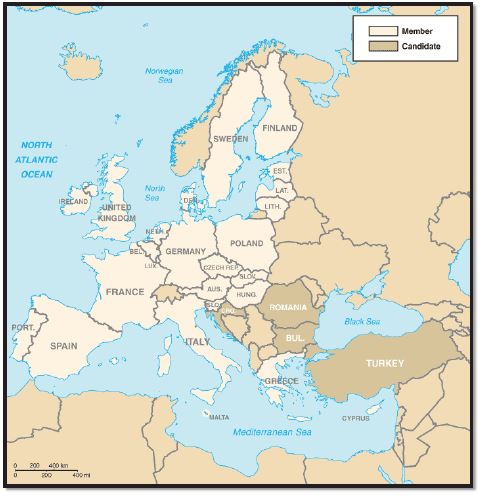71 8.3 COOPERATION BETWEEN STATES
In order to provide shared military and economic security as a unified entity, states engage in alliances. Military alliances help protect states from common enemies, and economic alliances allow for the free exchange of goods in a larger market. These alliances are also referred to as supranational organizations, and they all involve states giving up some of their sovereign power for the common good.
The largest supranational organization in the world is the United Nations (UN). Formed originally as the League of Nations after World War II, the UN now includes 193 states. The work of the UN includes peacekeeping, humanitarian relief, and the establishment of internationally approved standards of behavior. The headquarters of the UN is in New York City, and important subsidiary organizations of the UN include the World Health Organization (WHO), UNESCO (United Nations Educational, Cultural and Cultural Organization) and the Food and Agriculture Organization (FAO).
8.3.1 Military Alliances – NATO and Warsaw Pact
In terms of military alliances on a regional scale, the North Atlantic Treaty Organization (NATO) comprises 28 states and was developed after World War II to counter the threat of the former Soviet Union. Member states include numerous Western European states as well as the United States and Canada (Figure 8.2.). When the Soviet Union existed, the Warsaw Pact was a military alliance between the Soviet Union and seven satellite states of Eastern and Central Europe (Figure 8.2). The Warsaw Pact disbanded in 1991, and several of the former Soviet states as well as satellite states have subsequently joined NATO. As a result, Russia has felt isolated and vulnerable, and as a result, has been aggressively acting to seize or control territories in states close to its borders.

Figure 8.2 | Current NATO map and former Warsaw Pact
Author | User “Alphathon”
Source | Wikimedia Commons
License | CC BY SA 3.0
For example, in 2008, Russia engaged in a military conflict in Georgia, one of the former Soviet states, in order to support a separatist movement allied with Russia. In 2014, Russia invaded the peninsula of Crimea, within the territorial boundaries of Ukraine, one of the former states in the Soviet Union. Furthermore, Russia has intervened militarily against the rebel forces fighting in eastern Ukraine. In response to these provocations, NATO commenced Operation Atlantic Resolve, an ongoing series of training exercises between the United States and other NATO countries in former Warsaw Pact countries such as Poland, Romania, and Latvia.
8.3.2 Military Alliances – Terrorism
Although terrorists are characterized as non-military, non-state actors, they have a tremendous impact on states around the world and involve allied groups in many countries. Terrorism is the intimidation of a population by violence in order to further political aims. The first terrorist group with global influence is Al Qaeda, formed in 1988 by Osama bin Laden. Although its influence has waned in the past decade, Al Qaeda was responsible for the 9/11 attacks and had several affiliates including Boko Haram in Nigeria and Abu Sayyaf in the Philippines. With the rise of the Islamic State (ISIS/L) in Iraq and Syria in 2013, terrorist groups such as Boko Haram and Abu Sayyaf have consequently declared allegiance to ISIS/L. ISIS/L is an extremist Muslim group that intends to seize as much territory as possible in the Middle East and force their subjects to adhere to their strict version of Islamic fundamentalism. To facilitate their goal, ISIS/L conducts an extensive campaign on social media to recruit fighters to come to Syria and also conduct individual attacks in their home country. Their media campaign has been successful in recruiting numerous militants to come to Syria and to inspire or instigate attacks in the United States, France, Belgium, England, Sweden, Turkey, Afghanistan, Yemen, and Saudi Arabia (Figure 8.3). Furthermore, ISIS/L is conducting regular military operations in Libya and Egypt.
To combat the Islamic State and other terrorist groups, interesting military alliances have developed, and the situation is exceptionally complex. The United States cooperates with numerous NATO allies to train and equip local military forces in Iraq and Syria. Iran, in alliance with Iraq, has provided assistance in driving ISIS/L out of Iraq. Kurdish forces in northern Iraq and Syria, in concert with NATO forces, have conducted much of the military action, and they hope for an independent state because of these efforts. Complicating this situation is the objection of the central governments of Iraq, Syria, and Turkey to an independent Kurdish state. Further clouding the situation is the alliance between Russia and the Syrian central government. Although these two countries do fight against ISIS/L, they are also opposed to other Syrian rebel forces, which the United States supports. The problem of ISIS/L propaganda is being addressed by numerous governments and social media outlets such as Facebook, Twitter, and YouTube. More importantly, though, military success on the ground against ISIS/L forces in Iraq and Syria is decreasing the influx of foreign fighters as well as the proliferation of internet propaganda.

Figure 8.3 | Map of ISIS/L global influence 1
Author | Corey Parson
Source | Original Work
License | CC BY SA 4.0
8.3.3 Economic Alliances – European Union and NAFTA
One of the most prominent economic alliances in the world is the European Union (EU), which consists of 28 member states (Figure 8.4). What began as the European Community (EC) in 1958, the European Union has grown significantly from the original six members and now includes seven Eastern European states that were formerly in the Soviet Union. The EU has developed a common currency, the euro, for all member countries and a European Central Bank. Furthermore, at most boundaries, a passport is not required to enter another country.
One of the weaknesses of the EU is the need to subsidize poorer countries, creating financial difficulties for the more wealthy members. For example, Greece has experienced large debts that have required rescue funding from the EU. Another issue confronting the EU is whether or not to allow Turkey to join, as Greece has long-standing disputes with Turkey over territory in Cyprus, and the Turkish central government has been accused of anti-democratic practices. Perhaps most concerning for the EU is the imminent departure of the United Kingdom (UK) from the alliance in an action termed “Brexit.” In 2016, the UK voted by referendum to leave the EU, and is on schedule to formally break away in 2019. The UK’s decision to leave the EU is not solely related to economics, as not only is the EU an economic alliance, but agreements on social and political policies are involved as well. The majority of British citizens are generally against the subsidizing of poorer states and the increasing number of immigrants who use scare public resources, and they generally desire greater autonomy. With the exit of Britain from the EU, EU members are concerned that other states may follow suit.

Figure 8.4 | European Union
Author | U.S. Central Intelligence Agency
Source | Wikimedia Commons
License | Public Domain
An important economic alliance for the United States is the North American Free Trade Agreement (NAFTA). Established in 1992, this alliance integrates the United States, Mexico and Canada and facilitates the flow of goods and services across borders. The Trump administration has repeatedly criticized this agreement, as manufacturers have relocated production to Mexico which has resulted in the loss of manufacturing jobs in America. Whether or not the United States withdraws from NAFTA or simply renegotiates the agreement remains to be seen.
Another significant alliance that is being considered is the Trans-Pacific Partnership, an agreement between 11 countries that border the Pacific Ocean, and originally included the United States. The proposal was signed in February 2017, but the United States had already withdrawn from the agreement in January of the same year, making ratification virtually impossible. The goal of the agreement is to promote economic prosperity by lowering tariff barriers, but also promote environmental and labor protections as well as protect intellectual property. Critics say that it would result in the loss of U.S. jobs and weaken the sovereignty of the U.S.
